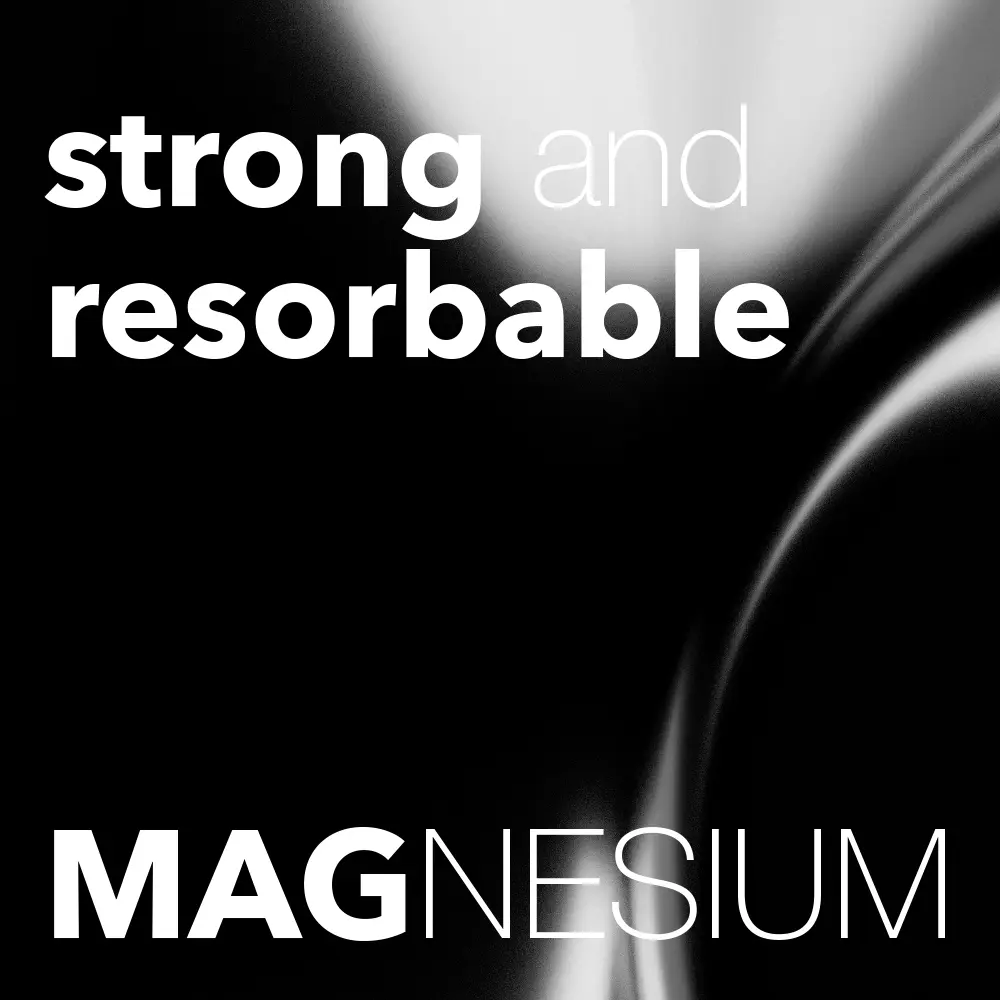

Magnesium in dentistry
A game-changer for bone
regeneration and tissue repair
Magnesium, the eighth most abundant element on Earth, plays a fundamental role in various physiological processes in the human body. It serves as a cofactor for over 300 enzymes, influencing essential functions such as muscle contraction, neuromuscular conduction, myocardial contraction, and blood pressure regulation. Around 50–60% of the body’s magnesium is stored in bones. Nowadays, it has become a promising biomaterial due to the combination of its biocompatibility, mechanical properties and biodegradation.
Magnesium at a glance
- Essential for healthy bones and bone growth
- Regulates muscle contraction and supports muscular function
- Vital for proper nerve function
- Crucial in energy production for cellular processes
- Key player in maintaining healthy blood pressure regulation and heart rhythm
Magnesium in Modern Dentistry:
Healing, Regeneration and Beyond
Mechanical strength and biodegradability for
optimal bone healing
Unlike other metallic biomaterials with excessive stiffness, magnesium offers a unique combination of malleability and structural integrity, making it well-suited for biomedical applications 1, 2. When implanted in the body, magnesium metal naturally degrades into magnesium salts, which are safely resorbed in the human body without immune reaction.
Magnesium offers the perfect balance of strength and biodegradability for bone healing. It supports regeneration, dissolves naturally without immune reactions, and eliminates the need for removal surgeries—ensuring efficient, patient-friendly healing.
Due to its biodegradability, a secure structure is provided during the critical healing period, followed by the replacement by patient’s native tissue 3. Furthermore, magnesium’s ability to maintain space within the defect site ensures optimal conditions for bone growth while preventing soft tissue proliferation in the critical space required for bone regeneration 3, 4.

„Materials completely resorbed after 4 months entry yielding unexpected bone volume vertically and horizontally way beyond our expectations. The products are a true breakthrough and will change bone grafting immensely.“ Prof. Gabi Chaushu, Head Department of Oral & Maxillofacial Surgery, Tel Aviv, Israel
Bone Regeneration and Osteogenesis

Magnesium ions enhance mineralization and promote bone remodeling processes.
Magnesium plays an essential role in promoting osteogenesis and facilitating new bone formation through its diverse biological effects. Magnesium ions create an optimal microenvironment for bone regeneration by establishing favourable alkaline conditions and stimulating the proliferation and migration of bone marrow-derived mesenchymal stem cells, expediting the regeneration process 5, 6.
Additionally, Mg2+ ions promote osteoblast adhesion, proliferation, and differentiation by activating key signalling pathways. This activation drives the production of essential bone matrix proteins, which, in turn, support angiogenesis, bone healing, and robust tissue regeneration 7-10. In dental applications, this property is especially significant for alveolar bone augmentation, where rapid bone growth is critical for stabilizing implants and reconstructing bone defects.
Dental products
with Magnesium
Every bone augmentation procedure is unique, necessitating the use of materials
with diverse properties. Until now, the choice has been between mechanically strong,
non-resorbable materials that either remain permanently in-situ or are extracted with
a second surgery, or resorbable materials that are either soft and durable or hard and brittle. To fulfill the need for a resorbable augmentation material that is both strong and durable, the NOVAMag® product line was developed.
Formation of Cortical Bone and Bone Quality
Magnesium’s role in osteogenesis extends to the formation of cortical bone, the dense outer layer of bone that provides structural integrity and support. Research has shown that magnesium-based biomaterials enhance osteoblast function, promoting mineral deposition and accelerating cortical bone formation. Studies indicate that magnesium-derived materials lead to the development of a more uniform and denser bone structure compared to traditional biomaterials. Furthermore, the degradation products of magnesium, such as magnesium hydroxide, have been found to facilitate localized mineralization, which further supports the development and strengthening of cortical bone 11,12.

Magnesium supports bone mineralization and improves bone microarchitecture.
A Natural Advantage in Dental Medicine
The ideal barrier membrane design is strong enough to protect the defect while being degradable and maintaining cell occlusivity during healing. Magnesium-based membranes are perfect for regenerative surgeries, offering the mechanical stability of metal while ensuring reliable degradation and resorption. This eliminates the need for membrane removal, reducing surgeries, invasiveness, and chair time.
See Dr. Erick Motas Webinar:
Management of compromised sockets using Magnesium Shield Technique.
The Webinar ist held in spanish with english subtitles
Magnesium in bone and tissue repair
- Boosts osteoblast activity and promote bone remodelling processes.
- Improves bone microarchitecture, enhancing cortical bone formation
- Promotes angiogenesis and enhances blood supply to the surrounding tissues.
- Modulates the immune response, creating optimal conditions for osteogenesis.
Fuel for Faster Bone Healing :
Promotion of Vascularization in New Bone Formation

Magnesium promotes angiogenesis
and enhances blood supply to the surrounding tissues.
Magnesium’s biodegradation process also releases Mg2+ ions that have been shown to stimulate angiogenesis which in turn supports tissue repair. Additionally, these ions have been shown to enhance angiogenic responses, which are crucial for supplying oxygen and nutrients to regenerating bone tissue. Adequate vascularization accelerates the healing of bone defects, supports dental implant integration, and is essential in guided tissue regeneration (GTR) techniques. Ensuring an adequate blood supply, accelerates the healing process of alveolar bone defects, supports the integration of dental implants, and plays a crucial role in tissue regeneration techniques, where soft tissue healing is as critical as bone regeneration 13,14.


















